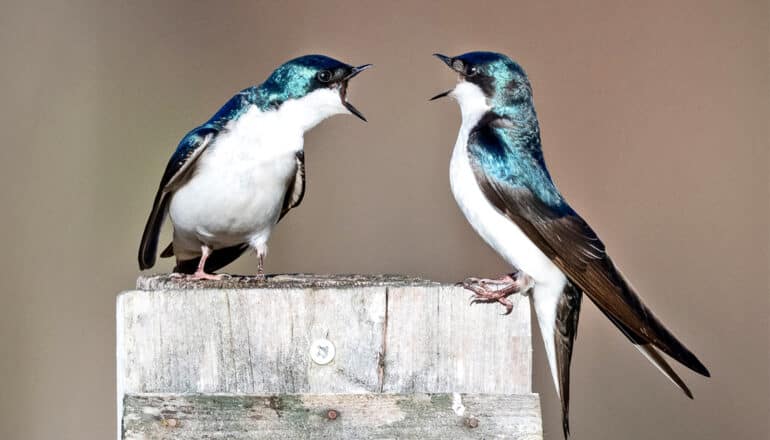
New research on bird behavior suggests that evolution may repeat itself.
Scientists have long wondered whether evolution would follow the same path if history had a chance for a “do-over.”
The new research suggests that it does, when it comes to the brain and its regulation of behavior—one of nature’s most complex traits.
This discovery sheds new light on the origin of behavioral variation.
The study appears in Nature Ecology & Evolution.
Together, the team found that bird species who nest in hard-to-get tree cavities have independently evolved heightened aggression, particularly in females. Even more striking, researchers found this behavioral similarity across lineages mirrored molecular similarity in the birds’ brains.
To conduct this work, researchers observed wild birds and measured their aggressive response to a stuffed decoy and a speaker playing aggressive calls. They replicated this territorial challenge for hundreds of birds across five branches of the bird family tree: swallows, wood warblers, sparrows, thrushes, and wrens.
In each lineage, they focused on two closely related species: one obligate cavity-nester, and one with a more flexible nesting strategy. Obligate cavity-nesters cannot reproduce without securing a hole in a tree or another similar structure. The team expected that these species would be more aggressive due to their nesting constraints.
“I have been studying cavity-nesters, like tree swallows and bluebirds, for over 20 years,” says Kimberly Rosvall, an associate professor in the biology department at Indiana University.
“We knew they fiercely defend their nesting territories, including those human-made bird boxes you might see in your local park. Now we know this ever-present competition also shapes their brain evolution.”
Out of over 10,000 genes expressed in the brains of all 10 species, the team found a set of genes that were consistently altered in their expression in the cavity-nesters’ brains. Each time a lineage evolved higher aggression, its brain independently had the same changes as other cavity-nesting lineages.
“It’s a small number of genes,” Rosvall says. “But it’s exciting because evolution did repeat itself. We knew this could happen for physical traits but not for a complex behavior like aggression.”
The researchers also identified a larger set of genes that was associated with aggressiveness along two or three branches of the bird family tree, showing “There may be many ways to build an aggressive bird.”
This study is a major advance because it shows that behavioral evolution can arise from a combination of independent changes in the brain, layered atop reuse of the same genetic toolkit.
“If you asked five artists to paint the same landscape, you might expect to recognize each painting as the same scene, even if they also look a bit different,” Rosvall says.
“Our results are like that, except the artist is natural selection, repeatedly dialing up aggression over the last 25 million years.”
The findings highlight both the predictability and creativity of evolution, but they also may inform human health.
“Our results did not flag the stereotypical ‘aggression’ genes, like those related to testosterone,” Rosvall says. “Instead, we saw convergent increases in aggression linked to genes with connections to neurodegenerative disorders.
“This doesn’t mean aggressive birds are going to get Alzheimer’s. It just means evolution has repeatedly tweaked these genes to shift brain function and behavior. And understanding why might help us develop evolution-inspired support for people.”
The research received support from the National Science Foundation.
Source: Indiana University
The post Aggressive birds reveal how evolution repeats itself appeared first on Futurity.


 1 month ago
20
1 month ago
20 




.jpg.webp?itok=1zl_MpKg)





 Bengali (Bangladesh) ·
Bengali (Bangladesh) ·  English (United States) ·
English (United States) ·